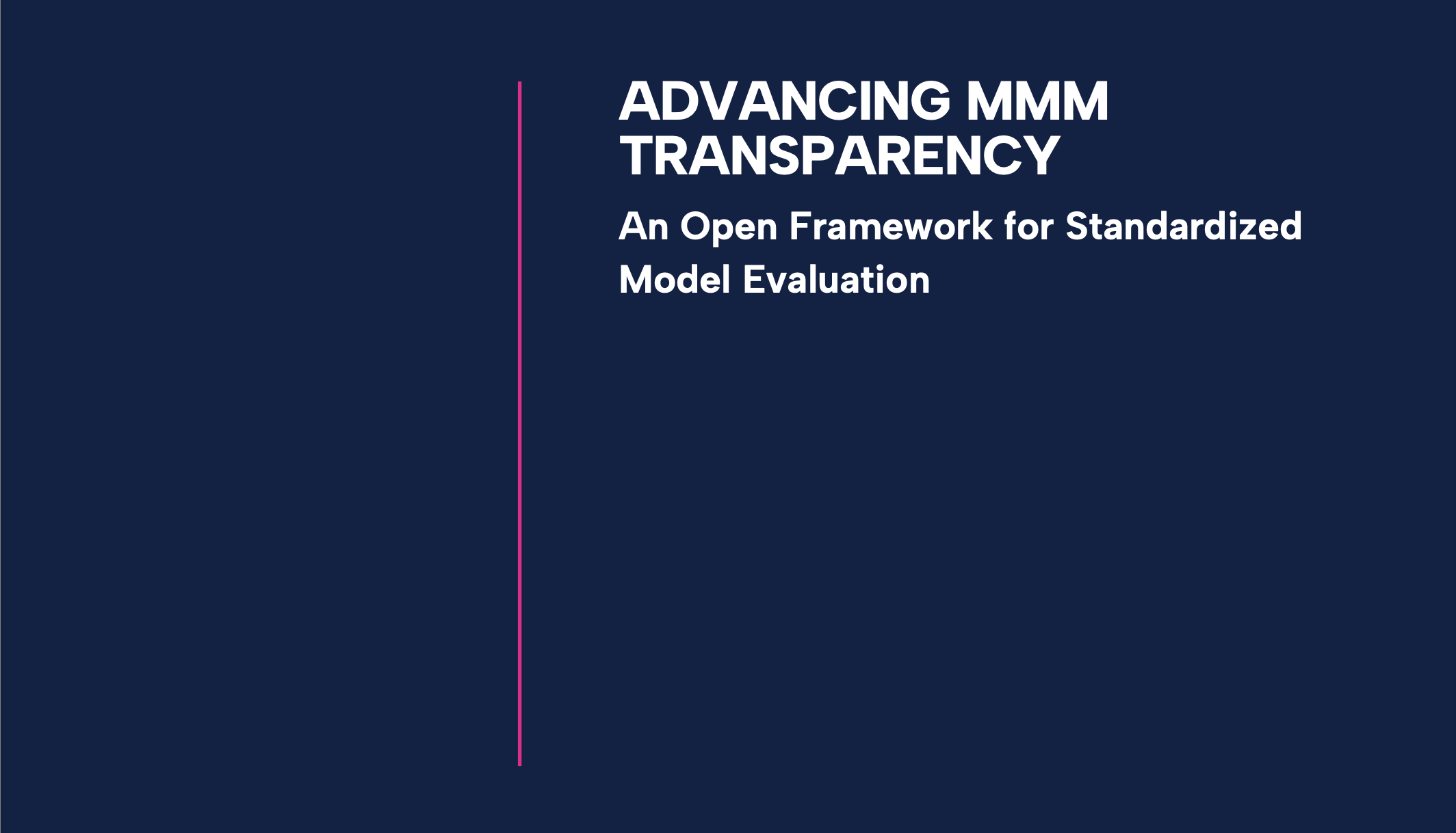As a marketer, you live and breathe ROI. You’re constantly asked to justify your marketing spend, prove the value of your campaigns, and decide where to invest the next dollar for maximum impact. In a world of fragmented channels and complex customer journeys, this is no small feat.
This is precisely why Market Mix Modelling (MMM) exists. At its core, an MMM is a powerful statistical engine designed to untangle the web of your marketing activities and external factors (like seasonality, competitor actions, or economic trends) to quantify how much each element contributes to your business outcomes.
But building a model is only half the battle. Handing a marketer a set of ROI figures without rigorous validation is like handing a pilot a new set of flight instruments without calibrating them first. They might look impressive, but you wouldn’t bet your business on them.
My central hypothesis, born from years of building and deploying these models, is this: MMM models are notoriously difficult to validate. The data is messy, the variables are intertwined, and the real world rarely fits into a neat statistical box.
However, it’s this difficult, methodical process of validation that transforms an MMM from a “black box” of numbers into a trusted, strategic tool for growth, a critical part of ensuring your marketing effectiveness. It’s how we prove a model is not just explaining the past, but can be relied upon to predict the future.
A Quick Detour: Why Model Type Matters in Marketing Analytics and Validation
Before we dive in, it’s important to distinguish between two types of models: deterministic and probabilistic.
A deterministic model is straightforward: for a given set of inputs, it will always produce the same single output. Think of it like a simple calculator. If it calculates your TV ROI is $2.50, it will always be exactly $2.50. This is clean, but it hides a dangerous truth: uncertainty.
A probabilistic model, like the Bayesian models we build at Mutinex, operates differently. It accepts that the world is uncertain and that our knowledge is imperfect. Instead of one answer, it produces a range of plausible outcomes. It won’t just say the TV ROI is $2.50; it will say, “We are 90% confident that the true ROI for TV lies between $1.80 and $3.20.” This single difference has massive implications for validation, especially when it comes to managing risk and understanding uncertainty.
The Open MMM Validation Framework

The Five Pillars of MMM Validation
Effective validation isn’t a single checkmark; it’s a multi-front investigation. We need to pressure-test the model from every angle to ensure its outputs are accurate, robust, and, most importantly, believable. Here are the five key challenges and how to solve them.
1. Predictive Accuracy: Is the Model a Historian or a Prophet?
The Problem: The most common failure of a poorly built model is “overfitting.” This happens when the model learns the historical data too well, including all its random noise and meaningless correlations. It becomes a perfect historian of what happened last year but is utterly useless at predicting what will happen next quarter.
A Real-World Example: Imagine your sales data shows a spike every June for the last three years. At the same time, your company happened to run a small LinkedIn campaign every June. An overfit model might incorrectly attribute the entire seasonal sales spike to those small campaigns, concluding that LinkedIn has a phenomenal, 50x ROI. When you invest heavily in LinkedIn in September based on this “insight,” you’ll be sorely disappointed when the seasonal lift isn’t there.
The Test: Out-of-Time (OOT) Validation
This is the gold standard for testing predictive accuracy. Instead of training the model on your entire dataset, you hold back the most recent period (e.g., the last 6 months). You train the model on the older data and then ask it to “predict” the sales for the hold-back period. You then compare the model’s predictions to what actually happened, a vital test for validating forward-looking marketing performance.
What Good Looks Like: A strong model will have a low prediction error (often measured by MAPE – Mean Absolute Percentage Error) in the OOT period. This proves it has learned the genuine, underlying drivers of your business, not just the quirks of historical data.
2. Multicollinearity: Who Really Gets the Credit?
The Problem: Marketing channels rarely act in isolation. You might launch a new product with a simultaneous push on TV, paid search, and meta platforms. All your channels spike at once, and so do your sales. Multicollinearity is the statistical term for this entanglement, and it makes it incredibly difficult for a model to isolate the unique impact of each channel, or individual marketing mix elements.
A Real-World Example: For years, a retailer ran a heavy radio advertising campaign at the same time they sent out direct mail catalogues. Both activities ramped up into the holiday season. Their initial model couldn’t separate the two and gave almost all the credit to radio, suggesting the expensive catalogues had zero effect. The business knew this wasn’t right, but the model couldn’t untangle the overlapping signals.
The Test: Variance Inflation Factor (VIF) & Correlation Matrix
A VIF score is a statistical diagnostic that measures how much a variable is explained by other variables in the model. A score above 5 (and certainly above 10) is a major red flag, indicating that its effect is being confused with another’s. A simple correlation matrix can also quickly show which channels move in lockstep.
What Good Looks Like: By identifying high VIF scores, you can make strategic decisions. Sometimes this means combining the highly correlated channels into a single “synergistic” variable, especially when multiple marketing tactics are deployed in parallel. Other times, advanced probabilistic models can use “priors” (business assumptions) to help pull the signals apart. The validation forces an honest conversation about what can and cannot be measured independently.
3. Uncertainty: How Confident Are We in That ROI Figure?
The Problem: A single ROI number is a dangerous simplification. As a decision-maker, you need to know the potential risk. Is an ROI of 3:1 a sure thing, or could it just as easily be 1:1?
A Real-World Example: A deterministic model tells a CMO that the ROI for their YouTube spend is $4.00 and the ROI for their programmatic display is $3.50. The logical move seems to be shifting budget to YouTube. However, a probabilistic model reveals the full picture: the 90% credible interval for YouTube is ($1.00 to $7.00) while for programmatic it’s ($3.00 to $4.00). The programmatic investment is a far safer bet with a reliable return, while the YouTube ROI is highly uncertain. The single number hid this critical business risk.
The Test: Credible Intervals
This is where probabilistic (Bayesian) models are invaluable. They don’t output a single number; they output a probability distribution for every metric. We can inspect these distributions to see the range of plausible values for each channel’s ROI.
What Good Looks Like: Clear credible intervals allow you to make risk-adjusted decisions. You can confidently invest in channels with high ROI and tight, certain intervals, while treating channels with wide, uncertain intervals with more caution, perhaps flagging them for further testing or creative optimization. This kind of risk-adjusted decision-making ensures smarter marketing investments that reflect both data insights and business judgment.
4. Endogeneity: Is Marketing Driving Sales, or Are Sales Driving Marketing?
The Problem: This is a subtle but critical “chicken-and-egg” problem. Endogeneity occurs when an input variable is determined by the output variable. In marketing, this often happens when marketing budgets are set reactively.
A Real-World Example: Your team notices that sales for a product are trending upwards organically. In response, the brand manager decides to “ride the wave” and boosts paid search spend to capture this rising demand. A naive MMM sees two things happening at once: search spend going up and sales going up. It wrongly concludes that the increase in search spend caused the entire sales lift. In reality, the initial sales lift caused the increase in spend. The model has the causality backwards.
The Test: Geo-Based Models To Unlock Experiments Further
This is one of the most robust ways to validate causality. You run a controlled experiment in the real world. For instance, you increase TV spend by 30% in Texas but keep it flat in the rest of the country. You then check if the actual sales lift observed in Texas matches the lift your MMM predicted for a 30% increase in TV spend; and the MMMs pick this up as a signal and into priors.
What Good Looks Like: When the model’s predictions align with real-world test results, you have powerful evidence that it has correctly identified the true causal relationships between your marketing and your sales.
5. Plausibility: Does This Even Make Sense?
The Problem: Sometimes a model can be statistically sound but produce results that defy business logic. This is the final and most crucial “gut check.”
A Real-World Example: A model for a CPG brand once suggested that their out-of-home (billboard) advertising had a 20x ROI, making it their most effective channel by a huge margin. While statistically valid on paper, the marketing team knew this was implausible. Further investigation revealed the billboard placements were heavily concentrated around their largest retail partner’s stores, whose own promotional activity was the real driver of sales. The model had found a correlation, not a cause.
The Test: Contribution Charts & Response Curves
These are vital visualizations.
- Contribution Charts: Break down your total sales by driver (e.g., 60% baseline, 15% TV, 10% Search, 5% seasonality, etc.), giving you a practical lens into your marketing mix impact. Do these percentages feel right based on your investment levels and business knowledge?
- Response Curves: These curves show how the model expects sales to change as you increase spend in a channel. They should show diminishing returns—the first $1M you spend should be more effective than the tenth $1M. If a curve is a straight line to infinity, the model is wrong.
What Good Looks Like: The model’s outputs should align with your team’s collective business intuition. When they don’t, it’s not a failure; it’s an opportunity for discovery. It forces a deeper look into the data and assumptions, leading to a smarter, more robust final model.
From Model to Movement
Validation is not about ticking a box. It’s an iterative, collaborative process of questioning, testing, and refining. It’s how you ensure your MMM isn’t just a complex algorithm, but a reliable compass for navigating your market. Validated models strengthen the foundation of your marketing and promotional activities, turning insights into action with confidence.
The challenges are real because marketing is complex. But by systematically addressing predictive accuracy, multicollinearity, uncertainty, causality, and plausibility, you can move forward with confidence. A good MMM partner doesn’t just deliver a report; they guide you through this validation journey, building the shared conviction needed to make brave, data-informed decisions that drive real growth. This process also helps ensure that your marketing strategies remain aligned with evolving business goals and market realities.
Want to learn more about model standards? Ask for a demo of our GrowthOS platform today.





